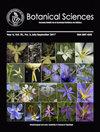青蒿在模式作物和农艺作物间生物除草潜力的选择性及其对苗期前后应用的影响
IF 0.7
4区 生物学
Q3 PLANT SCIENCES
引用次数: 0
摘要
背景:开发用于出苗前和出苗后应用的新型植物生物除草剂需要植物化学物质的功效和选择性。问题:在五种植物中,树蒿水提取物的植物毒性潜力如何变化?研究物种:作为模式物种的莴苣,两个单子叶植物(小麦、玉米)和两个双子叶植物(萝卜、豌豆)。研究地点和日期:在突尼斯西北部的Bousselem和Kef采集了两种树生蒿基因型;2021年3月。结果:水提物富含多酚、黄酮类化合物、缩合单宁和萜类化合物。对莴苣的发芽和幼苗生长的体外抑制潜力最高。8mg/mL的浓度对生菜的发芽具有完全抑制作用,对豌豆的发芽没有显著影响。在该浓度下,提取物对农艺作物的发芽抑制率分别为46-58%(萝卜)、74%(玉米)和72-78%(小麦)。根和芽生长的抑制率随施用浓度的不同而不同。体内试验表明,对莴苣和两种单子叶植物都具有较高的植物毒性。症状和生化特征的变化证实了这一点。结论:所获得的结果证实了树生A.arborescens水提取物的选择性生物除草活性,这促进了其作为开发新型植物生物除草剂的天然资源的潜力。本文章由计算机程序翻译,如有差异,请以英文原文为准。
Selectivity of the bioherbicidal potential of Artemisia arborescens L. among model and agronomic crops and implications for pre- and post-emergence applications
Background: The efficacy and selectivity of phytochemicals are required for the development of new botanical bioherbicides for both pre- and post-emergence applications.
Questions: How vary the phytotoxic potential of the aqueous extracts of Artemisia arborescens among five plant species?
Studied species: Lactuca sativa used as a model species, two monocotyledons (Triticum turgidum, Zea mays) and two dicotyledons (Raphanus sativus, Pisum sativum).
Study site and dates: Two Artemisia arborescens genotypes were collected at Bousselem and Kef, North West of Tunisia; March 2021.
Results: The aqueous extracts are rich in polyphenols, flavonoids, condensed tannins and terpenoids. The highest in vitroinhibitory potential on germination and seedlings growth was detected against Lactuca sativa. The concentration 8 mg/mL causes total inhibition of lettuce germination and has no significant effect on pea germination. At this concentration, the extracts inhibited the germination of the agronomic crops by 46-58 % (Raphanus sativus), 74 % (Zea mays) and 72-78 % (Triticum turgidum). The inhibition rates of radicles and shoots growth vary according to the applied concentration. The in vivo tests showed higher phytotoxic activity against Lactuca sativa and both monocotyledons. This was confirmed by the variation of the symptomatic and biochemical traits.
Conclusions: The obtained results confirm the selective bioherbicidal activity of A. arborescens water extracts which promote its potential as natural resource for the development of new botanical bioherbicides.
求助全文
通过发布文献求助,成功后即可免费获取论文全文。
去求助
来源期刊

Botanical Sciences
Agricultural and Biological Sciences-Plant Science
CiteScore
1.90
自引率
21.40%
发文量
71
审稿时长
16 weeks
期刊介绍:
Botanical Sciences welcomes contributions that present original, previously unpublished results in Botany, including disciplines such as ecology and evolution, structure and function, systematics and taxonomy, in addition to other areas related to the study of plants. Research reviews are also accepted if they summarize recent advances in a subject, discipline, area, or developmental trend of botany; these should include an analytical, critical, and interpretative approach to a specific topic. Acceptance for reviews will be evaluated first by the Review Editor. Opinion Notes and Book Reviews are also published as long as a relevant contribution in the study of Botany is explained and supported.
 求助内容:
求助内容: 应助结果提醒方式:
应助结果提醒方式:


